Abstract
Purpose: This article examines a field study I co-authored urging Washington State residents to register online as voters (Mann & Pryor, 2014).
Method: Using leading design principles, I created postcards for the Office of the Washington Secretary of State that were mailed to unregistered residents. In addition to measuring the overall effectiveness of the postcards, the study evaluated the differences between two rhetorical messages. Both postcards described the same registration process, but one focused on the user-friendly aspects of the online application while the other emphasized that registering to vote is a social norm.
Results: Residents in three counties with large Latino populations were mailed bilingual English-Spanish postcards. The total treatment effect was significantly higher among recipients in these counties than the rest of the state but with no noticeable difference between two rhetorical messages. Statewide, the overall results show that the postcard describing the voter registration experience as “fast and easy” was significantly more effective than persuading recipients to register using social pressure. Emphasizing convenience was especially effective among 18-year-olds.
Conclusion: The study suggests that election administrators can create a more culturally inclusive voter registration process by designing bilingual outreach materials. This article offers several lessons learned for voter outreach design and discusses potential avenues for the continued study of culturally inclusive UX practices as applied to voter registration outreach.
Keywords: rhetoric, voters, Latino, communication, design
Practitioner’s Takeaway:
- Bilingual design significantly increased voter registration in heavily Latino counties among people with Spanish surnames.
- Among recipients in heavily Latino counties, there was no significant difference between the two rhetorical methods tested. One treatment emphasized the convenience of the online voter registration process, and the other used social norming to encourage registration. Statewide, the majority of recipients were more likely to register when the postcard they received described the process as “fast and easy.” However, recipients of the two treatments in heavily Latino counties registered at nearly the same rate.
- Additional study of how bilingual outreach efforts affect users’ experiences with online voter registration could provide further insight to practitioners of both communication design and election administration.
Designing for a Culturally Inclusive Democracy
As a professional communication designer and certified Washington State election administrator, I’ve spent nearly a decade creating online and print tools that help voters cast an informed ballot. I designed several editions of the Washington State voters’ pamphlet, Washington’s official voter registration form, ballot instructions for Vote By Mail (a West Coast phenomenon that’s quickly spreading throughout the United States), and countless Get-Out-The-Vote marketing pieces.
For years, I tinkered with different rhetorical techniques, using methods that seemed most appropriate for the audience and medium. User-testing and focus groups provided some guidance, but I knew they weren’t a comprehensive picture of Washington’s diverse population, now numbering over 7 million people. So when the Office of the Secretary of State asked me to design postcards encouraging eligible Washington residents to register to vote prior to the 2013 General Election, I requested we use the postcards to study our rhetorical techniques.
This article discusses the field study I co-authored with Dr. Christopher B. Mann examining the effectiveness of social versus instrumental rhetorical methods of encouraging Washington State residents to register to vote (Mann & Pryor, 2014). This study provided new and valuable insights for election administrators to understand how the design of their voter outreach materials can impact citizens’ participation in our democracy. The primary goal of this study was to guide future communication design in order to increase voter registration rates. Additionally, I felt I could contribute to the limited body of interdisciplinary research connecting communication design with voter outreach, especially in heavily Latino communities.
Communication designers have drastically improved the means by which Americans vote since the infamous “butterfly ballots” drew intense public scrutiny in the 2000 presidential election (Lausen, 2007). Thanks to efforts like AIGA’s “Design 4 Democracy” initiative, today there are well-documented recommendations for ballot design, poll site signage, and voters’ pamphlets (Chisnell, 2013). But casting a ballot is the final step in the voting process; the first step is registration. In most states, citizens cannot vote without first registering.
Eligibility criteria and deadlines for voter registration vary state by state. For example, North Dakota citizens may register and vote on Election Day, whereas Washington State voters must register at least 29 days before an election. And some states have imposed photo ID requirements for registration, while in Washington State there is none. However, in Washington State, a driver license is still needed to register online in order to capture the voter’s electronic signature. These inconsistent regulations surrounding voter registration can be confusing and intimidating, especially for citizens with limited English proficiency. With more states moving toward online voter registration every year, bilingual voter registration outreach is an area ripe for collaboration between technical writers and UX professionals.
Although the pioneering work done by Lausen, Chisnell, Quesenbery and others in this emerging interdisciplinary field have been enormously helpful to voters attempting to cast a ballot, very little communication design research has been dedicated to the first step in the voting process: how and why citizens register to vote.
Theoretical Background
Social science literature frequently discusses what motivates voters, but people are too complex to credit a single variable. Fundamentally, scholars agree there are two general factors that influence voter participation. Wolfinger and Rosenstone’s classic discussion of Who Votes (1980) and Campbell’s The American Voter (1960) focus largely on social status indicators such as economic prosperity, educational attainment, and age. The statistical correlation between these demographic measurements and voting has been widely documented (Harder & Krosnick, 2008; Gonzalez & Tyler, 2008). For example, Watts (1999) speculates that older people habitually vote because they are more socially and financially invested in their communities. However, scholars such as Rusk (1974) and Timpone (1998) contend that the registration process itself may also impact voter participation. Timpone asserts that in the United States, the complicated two-step process of registering to vote and casting a ballot is inconvenient and may dissuade people from participating. Similarly, in a field study discussing voter registration methods, David Motz (2009) used mail pieces I designed for the Secretary of Washington State to demonstrate that more potential voters will participate given an easier, less time-consuming method of registration.
Although there’s not much communication design literature related to voter registration, broader research points to two rhetorical techniques used to motivate readers to achieve a document’s objective. According to Lentz and Pander Maat (2004), all documents—postcards, registration forms, cereal boxes, etc.—have a communicative purpose beyond presenting “just the facts.” In an interview ten years after her seminal work on document design, Schriver stated her belief that communication design synthesizes raw information into a message with a specific purpose for a specific audience (Carliner, 2007). Kain (2005) asserts that all documents function instrumentally to convey information and also function socio-politically to persuade the reader in ways that further the goals of the author. Just like political scientists recognize both social and process-related motives for voting, communication designers generally agree that documents also motivate readers through social and instrumental rhetoric (Hassett, 1996; Schriver, 1997). Good communication design uses socially persuasive techniques and aids comprehension to encourage or discourage a task, behavior, or opinion (Lentz & Pander Maat, 2004; Williams, 2007).
Both social status and the ease of the registration process play a role in voter participation, just like documents that function socio-politically and instrumentally to motivate readers. However, I have found only a handful of studies about non-partisan communication design techniques that can increase voter registration.
One of the few communication design studies discussing voter registration is a report written by Mann and Bryant (2012) for the Office of the Delaware Secretary of State comparing registration rates in response to four postcard treatments. Their study showed that postcard recipients were more likely to register when presented with an archetypal monochromatic “government notice” themed treatment, as opposed to full-color postcards featuring a patriotic call to civic duty. While the registration effect between these thematic treatments was statistically significant, it was unclear whether it was the visual imagery or the textual rhetoric that made the difference.
And as was previously mentioned, Motz (2009) demonstrated that more potential voters will participate given a less time-consuming method of registration. Using direct-mail pieces I designed, Motz found that, compared to a control group that received no treatment, sending unregistered 18-year-olds a postcard listing the online voter registration website garnered an 11 percent increase, and that sending a pre-filled voter registration form resulted in a 15 percent increase.
My project designing the 2013 Washington postcards and studying their effectiveness was a continuation of Mann’s research. However, the postcard treatments I designed were visually identical and varied only textually so that I could specifically test the effectiveness of social versus instrumental rhetoric. And unlike Motz’s study that tested two different registration methods, participants in this study were given identical means of registration; the only difference between the treatments was the perceived personal cost of registration (time and effort), not the actual cost itself.
The intent of the project was two-fold: first, to inspire eligible citizens to become registered voters, and second, to further cross-disciplinary knowledge of communication design and election administration.
Applying Design Theory to the Postcard Treatments
The postcards were meant to increase the number of registered voters in Washington State but also needed to convey practical information about the registration process, such as where to find the online registration website, the approaching deadline, and eligibility criteria. Additionally, some of the postcards had to provide Spanish translations.
A highly diverse electorate is a reality of modern America. Translated voter registration materials are required by Section 203 of the federal Voting Rights Act in jurisdictions whose residents meet specific low-English literacy thresholds. The U.S. Department of Justice publishes a list of jurisdictions covered by Section 203 and monitors for compliance. Providing well-designed translations can be a challenge for technical writers and UX professionals given the many legal and technical constraints of online voter registration systems. In Washington State, three heavily Latino counties—Adams, Franklin, and Yakima—must translate all print and online voting materials in Spanish. These counties fulfill their Section 203 requirements by providing fully bilingual English-Spanish voting materials, so I created a second set of postcards with the same rhetorical messages that met the bilingual requirements. Although this was not the only demographic subgroup we intended to measure within the field study, our hope was to compare the treatment effects of the bilingual postcards within these counties against the effects of the English postcards in other counties.
I designed two postcards with different rhetorical messages: the [Community] treatment that emphasized social rhetoric by increasing pressure to vote, and the [Online] treatment that emphasized instrumental rhetoric by highlighting the convenience of the online registration process. Table 1 summarizes the design theory applied to the 2013 Washington postcard treatments.
Visually, the postcard treatments were nearly identical. Likewise, the informational text on the back of both postcard treatments was also identical. Both postcards notified recipients that: “Our records show you are not registered to vote. To vote in the next election, you must register by the deadline. Online registration is quick and easy at www.myvote.wa.gov, or call (800) 448-4881 to request a paper registration form. You’re eligible if you are at least 18 years old, a U.S. citizen, and not under Department of Corrections supervision for a Washington felony conviction.” (See Figure 1.)
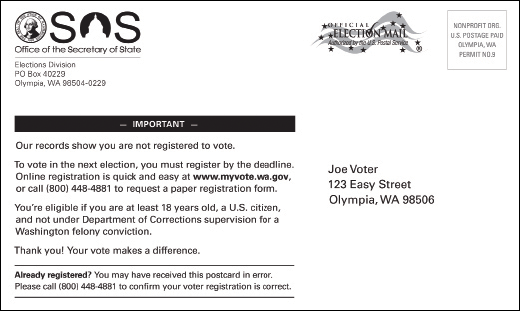
| Design theory applied to both treatments | Instrumental rhetoric emphasized in [online] treatment | Persuasive rhetoric emphasized in [community] treatment |
|---|---|---|
Visually:
|
Clearly states task: “Register to vote”
Summarizes steps for completion of task: “3 minutes. Click. Done.” Highlights speed and ease of task, reducing the perceived personal “cost” of registering to vote. Indicates mechanism for completing task: “online” and “click” Key descriptors by pre-test reviewers were “online” and “easy” |
Describes social norms to implicitly encourage similar behavior: “76% of people register to vote”
Offers method for improving social status: “join the community” Uses intentionally vague descriptor of the recipient’s social group: “people like you” Key descriptors by pre-test reviewers were “invitation” and “bandwagon” |
The variations to the two treatments were in the text on the front of each postcard:
The [online] treatment stated:
“3 minutes. Click. Done. Register to vote online.”
The [community] treatment stated:
“76% of people like you register to vote. Join the voting community.”
To a certain extent, both postcard treatments functioned persuasively to convince recipients that they should register to vote. For example:
- Urgency was identified as a motivational factor in Mann’s study of voter registration outreach with the Office of the Delaware Commissioner of Elections (2012). Therefore, the warning “deadline approaching” was featured in a bright red call-out banner across the front of both Washington treatments.
- The letter on the back of both postcards starts with, “Our records show you are not registered to vote.” Surveillance language like this proved extremely persuasive in a similar voter registration postcard campaign studied by Gerber and Green (2012), who demonstrated that recipients feel greater social pressure to modify their behavior when they know they are being watched or that their actions will be publically known.
- A study by Panagopoulos (2011; see also Mann, 2012) indicated that voters respond to simple gratitude for performing their public duty. Therefore, both treatments close with “Thank you! Your vote makes a difference.”
- Additionally, Mann (2012) indicated his belief that recipients of the 2012 Delaware postcards may have mistaken treatments featuring colorful patriotic imagery with political advertising or commercial marketing. Mann indicated that patriotic imagery reminding recipients of their civic duty wasn’t as effective as archetypal “government notice” imagery emphasizing the urgency of an approaching deadline. While the registration effect between these thematic treatments was statistically significant, it was unclear whether it was the visual imagery or the textual rhetoric that made the difference. Therefore, the 2013 Washington postcards are visually identical, thus removing imagery as a variable and focusing on the impact of textual rhetoric. Based on this, a primary design goal for the 2013 Washington postcards was to align both treatments visually with archetypal government notices that should be less likely to be mistaken for “junk mail.” To achieve this, both treatments used a limited color scheme and relied heavily on textual rhetoric rather than high-production imagery.
To function instrumentally, both postcard treatments instructed recipients as to how they could register to vote:
- A website for online voter registration was provided on both the front and the back.
- A toll-free phone number was also provided for recipients without Internet access to request a paper registration form via mail.
- Voter eligibility requirements were given on the back of both treatments.
The [online] treatment emphasized instrumental rhetoric, clearly stating the task asked of recipients: “Register to vote online.” (See Figure 2.) Johnson (2010) noted that instrumentally functional documents give readers multiple pathways to successfully complete their objective. Therefore, the front of the [online] treatment gave a succinct summation of the registration process for cursory readers (“3 minutes. Click. Done.”) while the back of the postcard provided more detailed instructions for more thorough readers. Although the [community] treatment provided exactly the same registration method, the [online] treatment highlighted the ease and speed by which recipients could register to vote online, thereby reducing their perceived cost of time and effort.
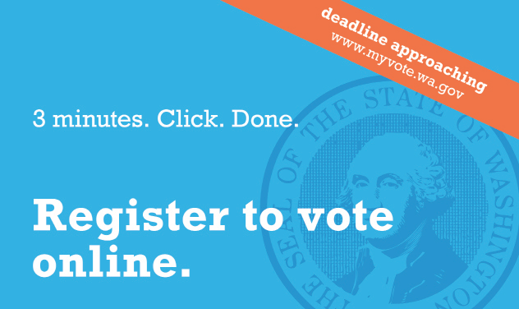
The [community] treatment emphasized persuasive rhetoric, telling recipients that “76% of people like you register to vote” and urging them to “join the voting community.” (See Figure 3.) When asked to describe the difference between the two treatments, pre-test reviewers confirmed the [community] treatment emphasized being a part of the group and used key descriptors such as “invitation” and “bandwagon” to summarize their reactions to the design.
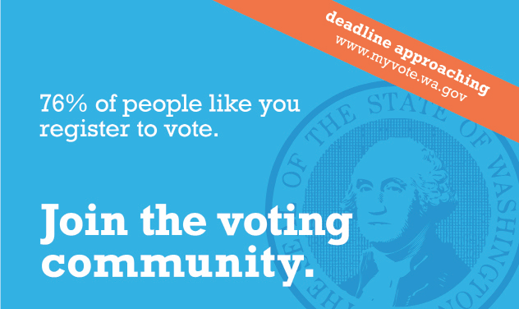
Bilingual Spanish-English postcards were mailed to participants in Adams, Franklin, and Yakima counties. (See Figures 4–6.) Although there may be some inherent bias in using a lighter, smaller font, this was standard practice for election administrators in those counties and the Secretary of State. The decision was made to use the existing style guide for bilingual publications so that an accurate assessment could be made regarding their effectiveness.
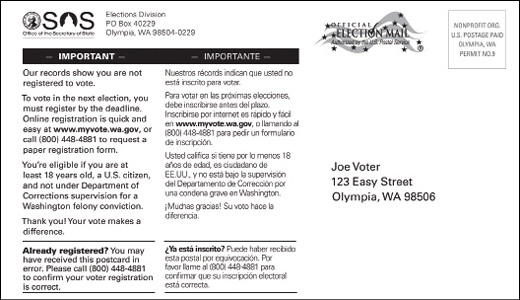
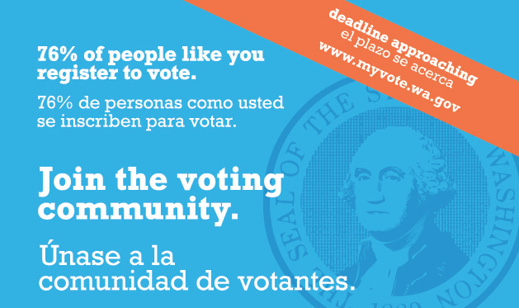
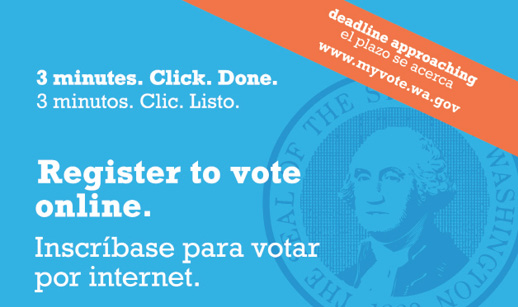
Field Study Methodology
The postcard project culminated with a field study funded by The Pew Charitable Trusts that evaluated the registration and turnout differences between the two rhetorical treatments.
The field study included 187,897 non-registered Washington State residents who were randomly assigned to two treatment groups and a control group that received no postcard. Participants living in Adams, Franklin, and Yakima counties were assigned to sub-groups of the treatment and control groups to accommodate the federally mandated Section 203 translation requirements. (See Figure 7.) Bilingual Spanish-English postcards were mailed to 10,860 participants in these counties, which represented 6% of the total number of participants who received postcards.
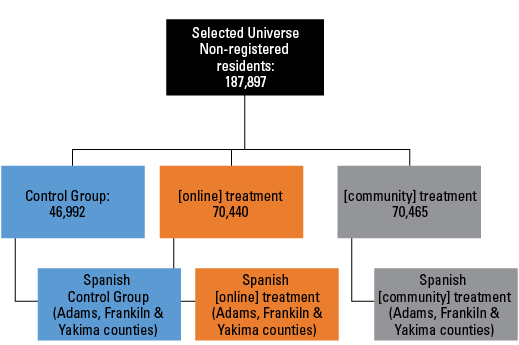
The postcards were sent prior to the 2013 General Election. Washington is part of a consortium of states that together manage the Electronic Registration Information Center (ERIC) to share voter registration and driver licensing data in order to maintain up-to-date voter rolls. ERIC generated a list of postcard recipients who were, prior to the voter registration deadline:
- A resident of Washington State
- At least 18 years of age by November 5, 2013 (the day of the General Election)
- A Washington driver license or state ID holder
- Not registered to vote at the address on file with the Department of Licensing
Each mailing was addressed by name. Although there is no research directly related to voter registration mailings, research on response to surveys, non-profit fundraising, and commercial mailings consistently finds that response rates are stronger for mailings addressed to individuals rather than “Postal Customer” or “Resident” (e.g. Dillman, Smyth, & Christian, 2008).
Results Show “Convenience” Rhetoric Is More Effective, Except in Latino Communities
The results of the field study show that overall, the [Online] treatment describing the registration process as “fast and easy” was more effective than attempting to persuade recipients to register using social pressure.1 (See Figure 8.) This suggests that potential voters were more motivated to participate given a registration process they perceived to be easier and less time consuming than when they were influenced by a sense of social responsibility or pride in their communities.
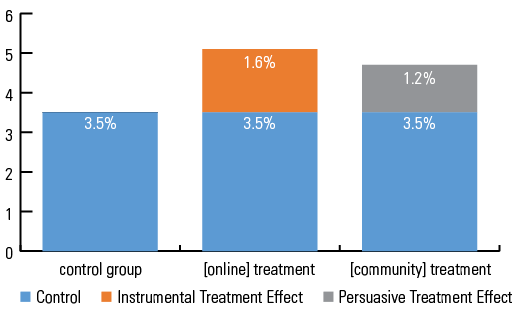
Unlike recipients who received English-only postcards, however, there was not a significant difference between the two rhetorical treatments among recipients in heavily Latino communities who were sent bilingual postcards. (See Figure 9.)
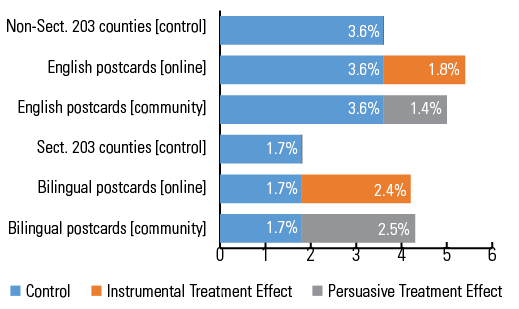
Digging deeper, we compared participants’ names to a list of Spanish surnames provided by the U.S. Department of Justice. Washington State law does not permit asking for ethnicity in the voter registration process, so this was our next-best option. Participants with Spanish surnames were assumed more likely speak Spanish, although some people speak both English and Spanish and some speak only English. To create a bigger sample, we pooled the data between the two treatments to analyze the effect of bilingual mailings between those with and without Spanish surnames.
Compared to the control group that received no postcard, the bilingual treatments significantly increased voter registration among individuals with Spanish surnames (1.0 percentage points)2 and individuals without Spanish surnames (0.9 percentage points)3 although the treatment effect between the two sub-groups were nearly equal. (See Figure 10).4
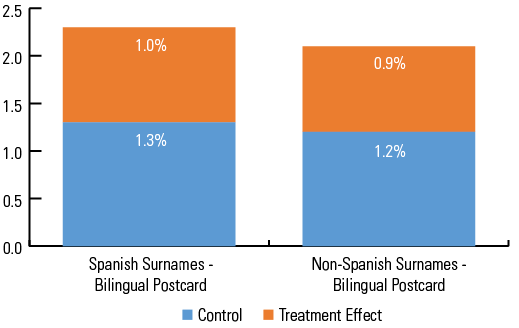
However, there was a statistically significant difference between recipients who received the English-only post card. (See Figure 11). As data show, recipients with non-Spanish surnames were seven times more likely to register given the English-only postcard than recipients with Spanish surnames:5 the treatment effect of the English-only postcards was 1.4 percentage points among individuals without Spanish surnames6 and only 0.2 percentage points among individuals with Spanish surnames.7
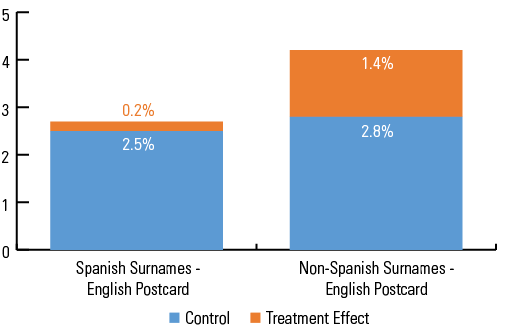
Looking at the same data set from a different perspective, we can see that participants with non-Spanish surnames who received the English-only postcard registered at a 50 percent higher rate than when they are given the bilingual postcard. (See Figure 12). And postcard recipients with Spanish surnames who received bilingual English-Spanish versions of the postcards were five times more likely to register than those who received English-only postcards (See Figure 13). Table 2 summarizes the registration data.
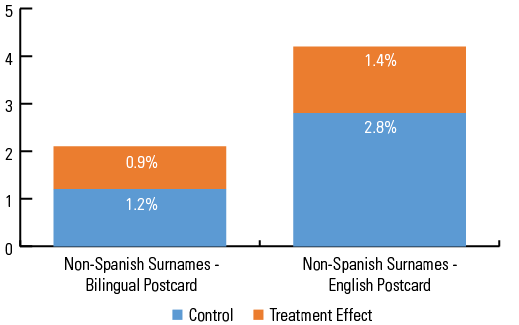
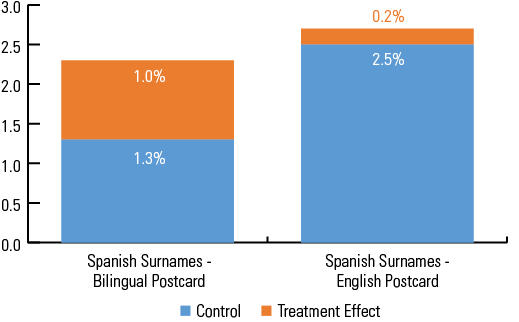
Again, I’ll reiterate that this approach of counting people with Latino surnames as Spanish-speakers has its flaws. People with Latino surnames do not necessarily speak Spanish, just as there are Spanish-speakers whose names do not sound Latino. This reflects the diversity of Hispanic populations. However, as a pilot study for designing more culturally inclusive voter registration materials, our method did provide some insights.
Lessons Learned: Guiding Future Voter Outreach Communication
This project used contemporary communication design theory to create postcards that were both easy to read and persuasive. Ultimately, the most significant lessons researchers and practitioners of voter outreach communication can take away from this field study are:
Among recipients with Spanish surnames, bilingual postcards encouraged higher registration rates compared to those who received English-only postcards.
Although instrumental rhetoric emphasizing the speed and ease of online voter registration was overall more effective, there was not a significant difference between the two rhetorical treatments in heavily Latino communities.
This study suggests that bilingual design can help create a more culturally inclusive voter registration process, but there is clearly more to learn.
This field study was a statistical survey of all eligible but unregistered Washington State residents that examined the effectiveness of different rhetorical treatments. Because we needed to pool the treatments to create a statistically significant sample size, we were unable to determine if Latino postcard recipients respond to social rhetoric at a higher rate than English-speaking recipients. This is difficult to accurately measure in Washington State, which does not permit the collection of ethnicity data when registering voters. For the purposes of this article, I excluded other sub-group data (age, gender, etc.) that was measured in the field study and focused on recipients of the bilingual English-Spanish postcards. However, this was not an in-depth case study of the effects of bilingual outreach materials on Latino voter registration. Additional study of bilingual voter outreach may reveal more specific findings.
Table 2. Voter registration data
| Control Group Registration Rate (no postcard) | Instrumental (online) Treatment Effect | Persuasive (social) Treatment Effect | Total Recipients | |
|---|---|---|---|---|
| Overall | 3.5% | 1.6 | 1.2 | 187,897 |
| English postcard recipients | 3.6% | 1.8 | 1.4 | 112,087 |
| Bilingual postcard recipients | 1.7% | 2.4 | 2.5 | 10,860 |
| Control Group Registration Rate(no postcard) | Combined Treatment Effect (“online” and “social”) | Total Participants | ||
| Bilingual postcard recipients with Spanish surnames | 1.3% | 1.0 | 3,565 | |
| Bilingual postcard recipients with non-Spanish surnames | 1.2% | 0.9 | 7,295 | |
| English postcard recipients with Spanish surnames | 2.5% | 0.2* | 12,080 | |
| English postcard recipients with non-Spanish surnames | 2.8% | 1.4 | 164,957 | |
* The increase in registration for the pooled treatment groups of English-only postcards among individuals with Spanish surnames is not statistically significant, p=0.248, one-tailed. All other registration effects are statistically significant.
As with all research conducted in the field, the results of this study may have been influenced by a number of factors, including the general low level of public interest in elections that is inherent in an odd-year, non-federal election (reflected by the low voter turnout statewide in 2013). The results of a similar study conducted during a different election year or in a different state may vary.
Although this was not an in-depth study of bilingual communication, our findings point to the need for future study. According to the National Conference of State Legislatures, 38 states currently offer or are developing online voter registration. As this new technology develops and states shift away from paper-based voter registration, I strongly believe that areas of future study should focus on bilingual communication design that increases the success rate of limited-English speakers attempting to register online. It is crucial that technical writers and UX professionals collaborate with election administrators to ensure we are designing a culturally inclusive democracy.
Notes
My deepest thanks go to Dr. Chris Mann for his expert advice conducting field studies and his unbiased analysis of the results, and to the Pew Charitable Trusts for funding this study.
Endnotes
- The difference between these treatments is statistically significant, p=0.001, two-tailed.
- The increase in registration for the pooled treatment groups among individuals with Spanish surnames is statistically significant, p=0.028, one-tailed.
- The increase in registration for the pooled treatment groups among individuals without Spanish surnames is statistically significant, p=0.004, one-tailed.
- The estimated effects are statistically indistinguishable, p=0.944, two-tailed.
- The estimated difference is statistically significant, p=0.007, two-tailed.
- The increase in registration for the pooled treatment groups among individuals with non-Spanish surnames is statistically significant, p<0.001, one-tailed.
- The increase in registration for the pooled treatment groups among individuals with Spanish surnames is not statistically significant, p=0.248, one-tailed.
References
Bacon, T. (2014, March 27). Speed and ease the keys to voter registration drives. Spokane, Washington. Retrieved from http://www.kpbx.org/spr-news-feed-entry-1669-speed-and-ease-the-keys-to-voter-registration-drives
Campbell, A. (1960). The American voter. New York, NY: Wiley.
Carliner, S. (2007). Ten years after: An interview with Karen Schriver about the lasting impact of the dynamics of document design. Information Design Journal, 15(2), 163–170.
Chapin, D. (2014, March 31). It helps to ask: New Washington state research demonstrates power of outreach on voter registration. Retrieved from http://blog.lib.umn.edu/cspg/electionacademy/2014/03/it_helps_to_ask_new_washington.php?utm_source=feedburner&utm_medium=feed&utm_campaign=Feed%3A+HHHElections+%28The+Election+Aacdemy%29
Chisnell, D. E. (2013). Field guides to ensuring voter intent: Field-researched, critical election design techniques to help ensure that every vote is cast as voters intend. Retrieved from www.CivicDesigning.org.
De Jong, M. D. T., & Schellens, P. J. (1998). Formative evaluation in document design: Validity of the plus-minus method for the pretesting of public information brochures. In Proceedings of the 1998 International Professional Communication Conference (pp. 123–130). Piscataway: IEEE.
Ding, D. D. (2000). Influence of Burke and Lessing on the semiotic theory of document design: Ideologies and good visual images of documents. Journal of Technical Writing and Communication, 30, 31–47.
Eisenlauer, V. J., & Hoffman, C. R. (2008). The metapragmatics of remediated text design. Information Design Journal, 16(1), 1–18.
Ganier, F. (2004). Factors affecting the processing of procedural instructions: Implications for document design. IEEE Transactions on Professional Communication, 47, 15–26.
Gerber, A. S., & Green, D. P. (2012). Field experiments: Design, analysis, and interpretation. New York, NY: W.W. Norton & Company.
Gonzalez, C. M., & Tyler, T. R. (2008). The psychology of enfranchisement: Engaging and fostering inclusion of members through voting and decision-making procedures. Journal of Social Issues, 64(3), 447–466.
Harder, J., & Krosnick, J.A. (2008). Why do people vote? A psychological analysis of the causes of voter turnout. Journal of Social Issues, 64(3), 525–549.
Harrell, C. A., Fineman, A., Newby, E., Chisnell, D., & Quesenbery, W. (2013). DUXU’13 Proceedings of the Second international conference on Design, User Experience, and Usability: web, mobile, and product design – Volume Part IV, 193–202.
Hassett, M. J. (1996). Teaching the rhetoric of document design. Business Communication Quarterly, 59(3), 65–67.
Hoeken, H. & Korzilius, H. (2003). Conducting experiments on cultural aspects of document design: Why and how? Communications, 28(3), 285–304.
Jarrett, C. (2000). Designing usable forms: The three-layer model of the form. Proceedings of the 47th Annual Conference of the Society For Technical Communication, Orlando, FL.
Johnson, J. (2010). Designing with the mind in mind. Waltham, MA: Morgan KauffmanPublishers.
Kain, D. J. (2005). Constructing genre: A threefold typology. Technical Communication Quarterly, 14, 375–409.
Lank, A. D. (2005, September 9). Making 1040s a bit less taxing: Form needs redesign, but it would be easy only in theory, IRS says. Milwaukee Journal Sentinel.
Lausen, M. (2007). Design for democracy: Ballot + election design. Chicago, IL: University of Chicago Press.
Leighley, J. E., & Nagler, J. (2007). Who votes now? And does it matter? Annual Meeting of the Midwest Political Science Association. Chicago: New York University.
Lentz, L., & Hulst, J. (2000). Babel in document design: The evaluation of multilingual texts. IEEE Transactions on Professional Communication, 43, 313–322.
Lentz, L., & Pander Maat, H. (2004). Functional analysis for document design. Technical Communication, 51, 387–398.
Mann, C. B & Pryor, L. (2014). 2013 ERIC voter registration outreach in Washington. Olympia, Washington: The Office of the Washington Secretary of State & The Pew Charitable Trusts. Retrieved from http://www.sos.wa.gov/_assets/elections/2013-ERIC-Voter-Registration-in-Washington-State-FINAL-3-20-2014.pdf
Mann, C. B. (2010). Is there backlash to social pressure? A large-scale field experiment on Voter mobilization. Political Behavior, 32, 387–407.
Mann, C. B. (2012). 2012 ERIC voter registration in Delaware.
Moore, P. (1993). Using gestalt theory to teach document design and graphics. Technical Communication Quarterly, 2, 389–410.
Motz, D. J. (2009). Making voting work for eighteen year olds. Olympia: Office of the Washington Secretary of State.
Panagopoulos, C. (2011). Thank you for voting: Gratitude expression and voter mobilization. Journal of Politics, 73, 707–717.
Popham, S. L. (2005). Forms as boundary genres in medicine, science, and business. Journal of Business and Technical Communication, 19, 279–303.
Ruesch, J., & Bateson, G. (1951). Communication: The social matrix of psychiatry. New York, NY: W. W. Norton & Company.
Rusk, J. (1974). The American electoral universe: Speculation and evidence. American Political Science Review, 68, 1028–1049.
Schriver, K. A. (1997). Dynamics in document design. New York, NY: John Wiley & Sons, Inc.
Timpone, R. J. (1998). Structure, behavior, and voter turnout in the United States. The American Political Science Review, 92, 145–158.
Washington study shows that easy registration motivates voters. (2014, March 26). Retrieved from http://www.pewstates.org/research/analysis/washington-study-shows-that-easy-registration-motivates-voters-85899542695
Watts, M. W. (1999). Are there typical age curves in political behavior? The “age invariance” hypothesis and political socialization. Political Psychology, 20, 477–500.
Williams, S. (2007). User experience design for technical communication: Expanding our notions of quality information design. Proceedings of the Annual Meeting of the IEEE Professional Communication Society.
Wolfinger, R. E. (1980). Who votes? New Haven, CT: Yale University Press.
About the Author
Lindsay Pryor is a public communications specialist. She is passionate about connecting citizens and government through UX and information design. Lindsay created award-winning online and print voter outreach campaigns for the Secretary of Washington State and provided UX guidance for their online voter registration system. Currently, Lindsay is developing outreach materials that help small businesses compete for local government contracts. Lindsay previously taught rhetoric at Wenzhou University and was Assistant Director of International Studies at Saint Martin’s University. She can be reached at lindsaypryor@gmail.com.
Manuscript received 15 August 2016, revised 1 February 2017; accepted 14 February 2017.

